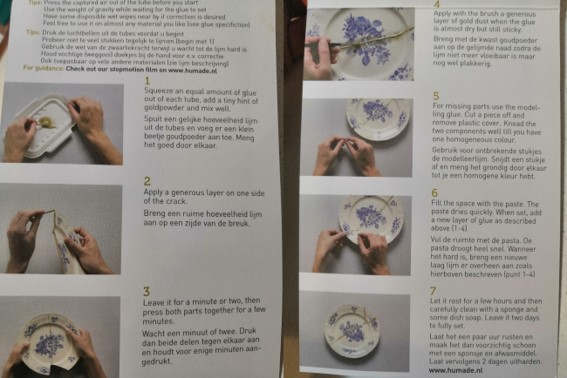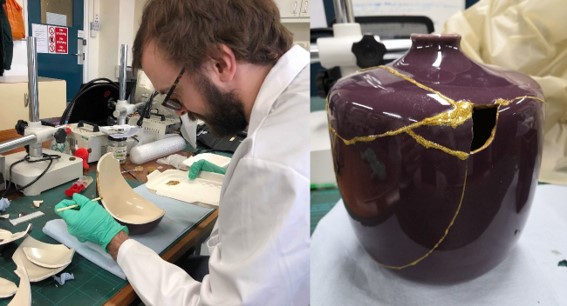If It Isn’t Broken, Don’t Fix It – A Critical Review of “New Kintsugi”, a Modern Take on a Traditional Repair Method.
29 January 2020After finding out about the technique of “Kintsugi”, an ancient Japanese technique of repairing ceramics with lacquer and gold powder, I was intrigued. After some further research, including reading Shan-Ying Chen’s previous blog post on the technique from November, I knew I wanted to learn more and at some point try the technique out for myself, as well as being keen to gain as much experience with joining and gap-filling of glass and ceramics as possible ready for my next main project. I must have excitedly discussed all of this with my girlfriend Siân as lo and behold, on Christmas day I unwrapped a Kintsugi kit from her!

I knew this wouldn’t be traditional Kintsugi, which is a multiple-stage technique that can take weeks to complete – for more information on the full traditional technique, see Shan-Ying’s blog. This was “New Kintsugi”, a term coined by Humade, the Dutch manufacturers of the kit. According to their website, “New Kintsugi is a new way of gluing porcelain based on the old Kintsugi technique”. Nevertheless, I was excited to try it out and after a trip to the charity shop for some choice smashable ceramic pieces, I was ready to experiment.
In the lab I started with the easy part – smashing the vase! Being careful to create as few pieces as possible, I took a hammer to the vase inside a canvas bag, and carefully checked the pieces all fit. The next step was to glue them back together. The method supplied in the kit was as shown below:

I could see some potential issues with this method but decided to try and follow it as closely as possible. Mixing the gold into the epoxy worked well, requiring only a tiny amount to get a strong vivid colour when applied. Obviously with regular ceramic repairs the objective is to be as seamless as possible; there should effectively be no raised edges to the join in cross section when done well. This take on Kintsugi however seemed to be actively relying on doing just the opposite! The “generous layer” of epoxy referred to in step 2 is required for the glue to be squeezed out along the length of the join and left to set sitting proud of the ceramic surface, hence why the gold powder is mixed into the epoxy itself. I quickly gave up on step 4, brushing on the gold powder before the glue dries, and this is the first major flaw of the kit I ran into – it is nearly impossible to successfully apply the gold powder in this way! Furthermore, this stage of the method seemed very wasteful regarding the powder itself, of which there was not a huge amount supplied. I was relatively happy with how the joins looked on the first vase without the addition of any extra gold, and so I disregarded this stage.

The next problem with the kit, and by far the biggest, came when I began working on the large vase. The epoxy provided in the kit, “Bison Epoxy 5 minutes”, was a perfect example of a terrible choice of adhesive! The long join surfaces of the pieces of this larger vase exposed the five-minute drying time as inappropriate for this technique. As I struggled for time before the epoxy dried, I started to rush, compromising the even application of the epoxy. This showed up when the pieces were joined, leaving some areas with plenty of epoxy showing and others with relatively little. Unbelievably, step 3 of the instructions suggests that once the epoxy is applied to “leave it a minute or two”, whereas I barely had time to apply it and get the joint in place before it became unworkable!

There was also some epoxy putty provided for gap filling. I had seen examples of Kintsugi with holes left in, presumably where large pieces were missing, and so I chose to leave the hole shown above in the large vase, partly because this is where the hammer shattered the pieces into small fragments, and partly as I like the effect. To the left of the hole you can see an area I gap-filled with the provided epoxy putty, which generally worked well. The only problem occurred when covering the exposed grey putty with the epoxy. Its viscosity was such that the additional weight of the greater amount required caused the mixture to run, which I managed to solve by positioning the vase on its side. There is however no indication in the instructions that this issue may arise.
Overall I am happy enough with the end results as a personal craft project I spent an afternoon on. Of course most people don’t have the kind of time to spare that traditional Kintsugi requires, and the goal of designing an accessible “off-the-shelf” kit to try out a modern take on this traditional method is certainly a good idea on the part of Humade. There are however some changes I would make to this kit, which I believe could vastly improve the experience.
The first option is to retain the same method but switch out the epoxy for a slower-drying alternative. This would allow for more care to be taken in both applying the epoxy evenly and in sufficient quantity, and a good fit to be found for the join whilst the glue is still workable. A small roll of masking tape could be included for holding the pieces in place whilst drying, as is commonplace with adhering ceramics with slow-drying adhesives.
The second option, and my preferred one, is to do away with the method of mixing the gold powder into the glue altogether. Instead there would be a gold paint provided, which the user would apply over the cracks after repairing them with the epoxy resin and letting them dry, replicating the effect of traditional Kintsugi in potentially a much more similar manner.
The splitting of the process into two steps – fixing the ceramic and then painting over the cracks – could slow the process down just enough, eliminating that feeling of being rushed I experienced whilst keeping the project achievable for the casual crafter. Indeed, slowing down is entirely in keeping with the ethos of Kintsugi; the technique is philosophically tied to ideas of self-healing. The broken ceramic is seen as an extension or aspect of oneself; we all experience hurt and “become broken” as such, and repairing this damage and embracing our imperfections should be a slow and mindful process.
- March 2024 (1)
- December 2023 (1)
- November 2023 (2)
- March 2023 (2)
- January 2023 (6)
- November 2022 (1)
- October 2022 (1)
- June 2022 (6)
- January 2022 (8)
- March 2021 (2)
- January 2021 (3)
- June 2020 (1)
- May 2020 (1)
- April 2020 (1)
- March 2020 (4)
- February 2020 (3)
- January 2020 (5)
- November 2019 (1)
- October 2019 (1)
- June 2019 (1)
- April 2019 (2)
- March 2019 (1)
- January 2019 (1)
- August 2018 (2)
- July 2018 (5)
- June 2018 (2)
- May 2018 (3)
- March 2018 (1)
- February 2018 (3)
- January 2018 (1)
- December 2017 (1)
- October 2017 (4)
- September 2017 (1)
- August 2017 (2)
- July 2017 (1)
- June 2017 (3)
- May 2017 (1)
- March 2017 (2)
- February 2017 (1)
- January 2017 (5)
- December 2016 (2)
- November 2016 (2)
- June 2016 (1)
- March 2016 (1)
- December 2015 (1)
- July 2014 (1)
- February 2014 (1)
- January 2014 (4)